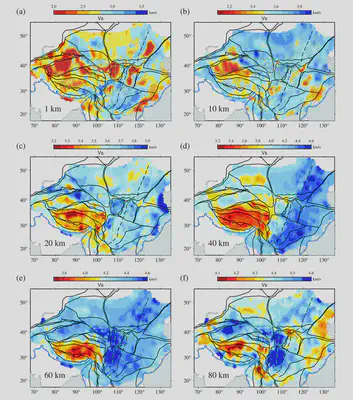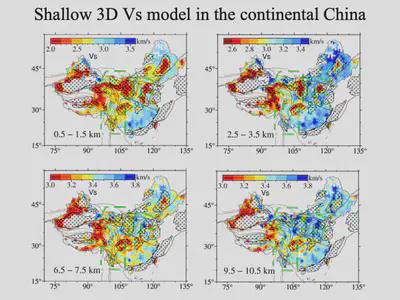China Seismological Reference Model
The China Seismological Reference Model (CSRM) project was initiated in 2016 by a working group composed of seismologists from major seismological research institutions across China, with the support from the National Natural Science Foundation of China (http://chinageorefmodel.org/). As a memeber of the CSRM construction group, following two studies conducted by me are parts of the entire CSRM project.
CSRM-1.0: A China Seismological Reference Model of the crust and uppermost mantle
We construct a high-resolution China Seismological Reference Model (CSRM-1.0) in the top 100 km of the crust and uppermost mantle in continental China following a top-down construction process. The employed seismic constraints include P-wave polarization angle from tele-seismic event, short-period Rayleigh wave ellipticity from ambient noise, long-period Rayleigh wave ellipticity from earthquake data, receiver function, empirical Green’s function from ambient noise, Rayleigh wave phase/group velocity dispersion curves from regional earthquakes, and Pn-wave travel time extracted from seismic data of 4435 stations. CSRM-1.0 has a spatial crustal resolution of ~60 km beneath the north-south seismic belt and trans-North China orogen regions and ~120 km beneath the rest of continental China, and a spatial mantle resolution of ~300 km. CSRM-1.0 exhibits prominent velocity heterogeneities in the crust and uppermost mantle and an eastward thinning of the crust, geographically correlating with geological settings. CSRM-1.0 improvements include accurate estimation of shallow seismic structure, increased spatial resolution and improved model accuracy. Crustal composition inferred from CSRM-1.0 exhibits a general transition from a felsic upper crust to a mafic lower crust. Mafic rocks in the lower crust are found predominantly along inter-block boundaries and sporadically within the interiors of blocks, likely resulted from preferential inter-block intrusions of magmas related to various oceanic plate subductions and the Emeishan mantle plume. This study contributes seismic constraints and CSRM-1.0 to the CSRM product center (http://chinageorefmodel.org) as a backbone open-access geophysical cyberinfrastructure. (Paper Link)

Shallow 3D shear wave velocity model of the uppermost crust beneath the continental China
We construct a high-resolution shallow three-dimensional (3D) seismic model in the top 10 km of the upper crust in the continental China, with constraints of P polarization, Rayleigh wave ellipticity and receiver function obtained from records of 3848 seismic stations. Our 3D seismic model has a spatial resolution of $0.6°-1.2^°$ in the north-south seismic belt and the trans-north China orogen, and $1^°-2^°$ in the rest of the continental China (except the Tarim basin and the southwest Tibet). The seismic model exhibits low velocity anomalies of deposits in major sedimentary basins and high velocity anomalies of crustal bedrocks in young orogenic belts and old tectonic blocks. The inferred sediment thickness maps display thick deposits in major sedimentary basins, some compacted sediments in the intermontane basins in young orogenic belts and little sediments in old tectonic blocks. We also discuss compaction effects of the sediments and implications of tectonic history and geological evolution of the major basins in the continental China based on the inferred seismic models. (Paper Link)
